Skateboarding Clothing Brands: Culture and Style
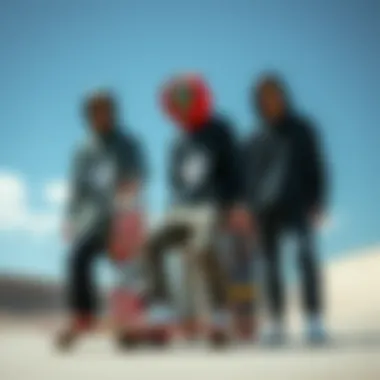
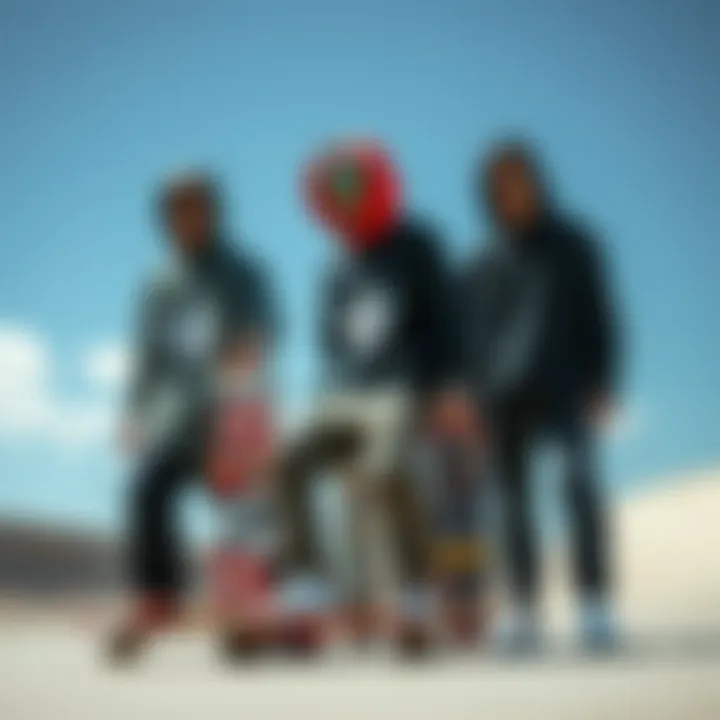
Intro
Skateboarding is more than just a sport; it's a vibrant culture that speaks to the spirit of freedom, creativity, and rebellion. At the heart of this culture lies the clothing that skateboarders wear, which embodies not only personal style but also functionality that meets the demands of the sport. Over the years, various skateboarding brands have emerged, each contributing uniquely to the fashion landscape surrounding skate culture. This article will explore a variety of these brands, their evolution, and the way they shape and reflect the ethos of skating.
From the baggy pants and graphic tees that define a generation to the innovations in material and design aimed at enhancing performance, the relationship between skateboarders and their clothing goes well beyond aesthetics. Indeed, the right apparel can make all the difference in a skater’s experience, influencing their movements and confidence on the board.
In this comprehensive overview, we’ll delve into the key players in the skateboarding clothing industry, examine the balance between style and function, and shine a light on how these brands cater to the diverse needs of skateboarders. Our journey will provide not just insights into individual brands but also a deeper understanding of the community and culture they represent.
Moreover, we will touch upon the importance of choosing skate clothing that not only looks good but also stands up to the rigors of skating. As the industry evolves, trends come and go, but the essential values of comfort, durability, and style remain paramount. After all, skaters don’t just wear their clothes; they live in them, and every stitch tells a part of their story.
The Evolution of Skateboarding Fashion
Skateboarding fashion isn’t merely about clothes; it embodies a culture that remains deeply intertwined with self-expression, rebellion, and style. Understanding the evolution of this fashion helps unveil the broader narrative of skate culture itself. From simple attire designed for practicality to vibrant streetwear that's as much about making a statement as it is about functionality, skateboarding clothing tells the story of a subculture that has thrived against the odds. The gear skaters choose reflects their identity, preferences, and even their politics, contributing to the diverse tapestry of urban culture. This section will explore the journey of skateboarding apparel, its roots, and how it came to shape the identity of countless skateboarders worldwide.
A Brief History
Skateboarding apparel has its origins in the late 1960s when surfers in California sought ways to recreate the thrill of riding waves on asphalt. Early skateboarders, often using makeshift boards, dressed in casual wear that allowed for movement. Think loose-fit shirts, shorts, and canvas shoes. As the years rolled on, the 1970s marked the emergence of dedicated skate brands like Dogtown and Powell Peralta, which began influencing the attire of skaters. Skate clothes during this period were decidedly utilitarian, designed to withstand the rigors of practice and tricks.
By the 1980s, skateboard fashion underwent a transformation fueled by the burgeoning punk and hip-hop scenes. Underground skate shops stocked graphic tees, baggy pants, and plenty of accessories, paving the way for logos and edgy designs. This decade was pivotal, as brands like Vans launched products tied firmly to skate culture. This combination of style and function appealed to young people who saw skateboarding as both a sport and a lifestyle.
During the 1990s and early 2000s, skateboarding became increasingly mainstream, leading to the commercialization of its fashion. Big-name brands began to recognize the potential of skate culture for profit, resulting in a mix of genuine and manufactured experiences. Clothing became more flamboyant, featuring bright colors and oversized fits, heavily influenced by hip-hop. Skate crews often coordinated outfits that reflected their unity and camaraderie.
Cultural Influences
The world of skateboarding clothing has always been a canvas for different cultural movements and societal trends. Fashion draws from various places — art, music, social movements — and skateboarding is no exception.
- Music Influence: Punk rock, hip-hop, and even jazz rhythms have shaped what skaters choose to wear. For instance, the rise of skate punk in the 1980s saw an explosion of band tees and more aggressive styles in skate fashion.
- Art and Design: Artistic expression finds its way into skatewear through collaborations with artists, graphic designers, and even tattoo culture. Skate decks adorned with original art are now synonymous with some of the most prominent skate brands, creating a visual language shared among skaters.
- Social Movements: Over the years, skateboarding apparel has also taken cues from broader social movements, whether environmental consciousness that fuels eco-friendly lines or inclusivity that embraces diverse identities in the community.
Ultimately, the evolution of skateboarding fashion is a reflection of its community, its struggles, and its triumphs. This is why, when one examines skate apparel, they are not just looking at fabric and stitches but instead, a vibrant history that resonates with people across the globe.
The Key Players in Skateboarding Apparel
Understanding the key players in skateboarding apparel is pivotal for anyone delving into the intricacies of skate culture. These brands aren't merely companies peddling clothing; they represent a lifestyle, an ethos, and a vibrant community that resonates deeply with skateboarders. The market is filled with a myriad of players, each contributing uniquely to the fabric of skate culture through design, functionality, and storytelling.
From time-honored names that paved the way in the 1980s to the more recent entrants that reflect modern sensibilities and priorities, identifying these brands helps enthusiasts make informed choices. Skateboarders, hobbyists, and even parents seeking to outfit their kids need to understand what these brands stand for, how they cater to different segments of the skateboard community, and what attributes set them apart in a crowded marketplace.
Established Brands
When discussing established brands in skateboarding apparel, names like Vans, Element, and Thrasher often spring to mind. These companies have built strong narratives around their products, integrating elements of street culture and skate lifestyle into their branding.
- Vans: Founded in 1966, Vans is arguably synonymous with skate culture. Their classic slip-ons have become a rite of passage for beginners and seasoned skaters alike. They not only produce footwear but also apparel that mirrors the edgy aesthetic of skateboards and their riders.
- Thrasher: Known for its punk rock style, Thrasher is more than just a magazine; it's a lifestyle brand. Their iconic flame logo is everywhere, symbolizing rebelliousness and authenticity. They cater to ardent skateboarders who appreciate a raw, gritty aesthetic that many mainstream brands might shy away from.
- Element: With a focus on eco-friendliness, Element has carved a niche by appealing to environmentally conscious consumers. Their use of sustainable materials and collaborations with artists reinforce their commitment to the skateboard community while hitting home the importance of preserving the spaces we skate.
These brands serve as a touchstone for many skaters. They remind users of the roots of skateboarding while also pushing innovation in design and functionality. Established players create a sense of reliability, ensuring skaters can count on quality and culture in their apparel.
Emerging Brands
On the flip side, the skateboarding apparel scene is rich with emerging brands that are shaking things up, often pushing boundaries in terms of design and sustainability. These brands are often spearheaded by young entrepreneurs or even professional skaters looking to bring a fresh perspective to the table.
- HUF: Founded by professional skateboarder Keith Hufnagel, this brand successfully combines skate culture with high fashion. By doing collaborations with various artists, HUF stands out in a marketplace that sometimes feels saturated by established giants. Their attention to detail and unique graphics attract a diverse clientele.
- Ripndip: Known for its whimsical designs and playful logo, this brand has gained significant traction among younger skaters who appreciate humor in their apparel. Their marketing approach, often through social media, has turned Ripndip into a recognizable name in the industry, particularly among Gen Z.
- Krooked Skateboards: Although primarily a skateboard brand, Krooked's clothing line is gaining momentum. Founded by skateboard legend Mark Gonzales, they emphasize creativity and self-expression, attracting those who think outside the box in both skating and style.
Emerging brands represent a new wave of creativity, often unburdened by long-standing traditions. They offer unique perspectives that can resonate with skaters seeking individuality in their clothing choices. These brands affirm that skateboarding is not merely a sport but an ever-evolving culture.
As more newcomers step onto the scene, the boundaries of what skateboarding apparel can be continue to expand. This fluidity mimics the very essence of skate culture, embracing change while nurturing a community rooted in passion for the sport.
Functional vs. Aesthetic Design
When it comes to skateboarding apparel, the push and pull between functionality and aesthetics is a constant dance. Both elements play vital roles in how skateboarders and enthusiasts approach their gear, balancing their desires for performance and personal style. The importance of understanding this balance is not only key to the identity of skate culture but also to the ongoing success of brands within this niche.

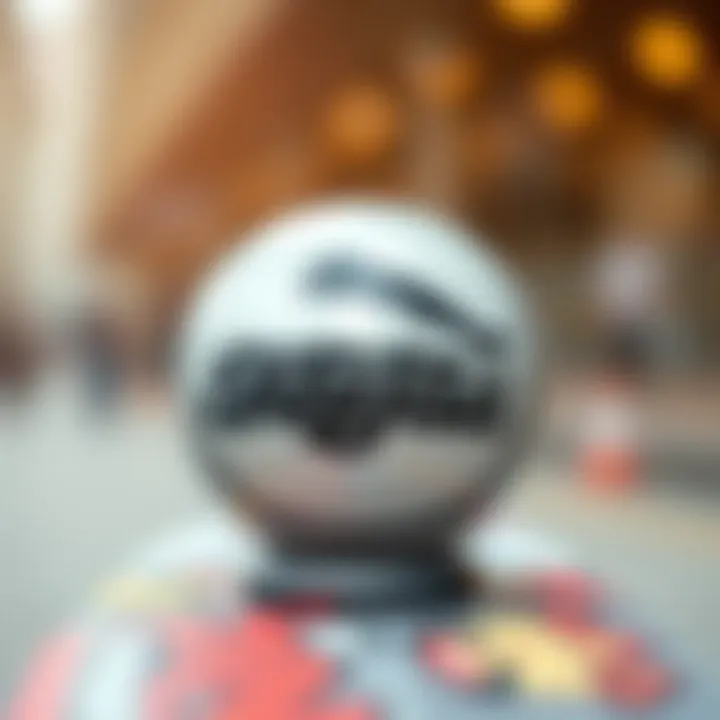
Balancing Form and Function
In the world of skateboarding, a rider's outfit often reflects their personality and their performance needs. For instance, a loose-fitting graphic tee may represent individual style, while board shorts tailored for mobility can enhance confidence on the board. The challenge for brands is to design clothing that meets both requirements.
- Durability is Key: Skateboarding can be hard on clothes; hence, fabrics must withstand substantial wear and tear. Consider brands like Thrasher or Vans. Their materials are engineered to handle falls and scrapes while maintaining comfort. This has become fundamental for both safety and long-term usage.
- Fit Matters: The rise of tailored cuts among various labels shows that fit is not just about looking good. A tighter fit may allow for greater movement, reducing the chances of snagging during tricks. Think about the decisions skaters make—long sleeves versus short, fitted versus relaxed. This choice can influence not only performance but how comfortable it is to skate for extended periods.
"Good skateboarding attire should feel like a second skin; it should move with you, not against you."
Materials That Matter
Material selection is where the magic truly happens. Skateboarding clothing isn’t just a style statement; it needs to serve practical needs without compromising on looks. Some materials have become staples in the industry, each offering unique benefits:
- Cotton Blends: Most common for everyday wear, cotton is breathable and comfortable. Brands like Element utilize cotton blends to get the best of both worlds: softness for comfort and enough strength to take a beating.
- Polyester and Nylon: Often found in skate shoes or jackets, these materials are lightweight and moisture-wicking. They offer enhanced durability and reduced drying time, which is beneficial when riding in varied weather conditions. Companies like DC Shoes leverage these attributes to ensure that skaters stay dry and fresh during long sessions.
- Stretch Fabrics: Elasticity is crucial when it comes to real skateboarding moves. Fabrics that incorporate spandex or other stretch materials can significantly improve flexibility in clothing, allowing for ease of movement during tricks.
- Sustainable Options: With rising environmental awareness, many brands are exploring eco-friendly fabrics like recycled polyester or organic cotton. This consideration not only helps the planet but can create a unique selling point that resonates with modern consumers who prioritize sustainability. Companies like Patagonia are pioneers in this niche, merging performance with environmental consciousness.
Popular Styles among Skateboarders
When it comes to skateboarding, style isn't just a matter of aesthetics; it's a fundamental part of the culture. The clothing choices that skateboarders make are deeply intertwined with their identity, lifestyle, and even their performance on the board. Understanding the popular styles among skateboarders offers insight into what defines skate culture today. It's about blending personal expression with the functionality required to skate effectively.
Streetwear Influence
In recent years, the streetwear movement has seeped into skateboarding fashion, creating a unique fusion that resonates with both communities. This influence is evident in the oversized tee shirts, baggy jeans, and bold graphic designs that have become staples in many skate wardrobes. Brands like Supreme and Thrasher have brilliantly marketed their iconic logos for both skaters and non-skaters alike, turning them into symbols of urban culture.
Skateboarders often gravitate towards streetwear because it reflects a certain attitude—rebellious yet stylish. The looser fits enable free movement, essential for tricks and jumps, while the bold graphics often hold cultural significance or humorous undertones that invite conversation.
- Casual graphic tees are comfortable and lightweight, perfect for warmer days.
- Hoodies are a go-to during colder months, offering warmth and style with the added bonus of a hood for those who wish to stay somewhat incognito.
- Footwear also plays a crucial role, with sneaker designs often reflecting the streetwear aesthetic, balancing comfort with the latest trends.
"Streetwear is not just an outfit; it's a lifestyle that complements the raw nature of skateboarding." - Anonymous
Casual and Functional Wear
While fashion trends ebb and flow, functionality remains paramount in skateboarding apparel. Comfort, durability, and practicality are vital considerations, ensuring that clothes can withstand the rigorous movements of skateboarding. This category includes items like cargo pants, which offer ample pocket space, and moisture-wicking materials that keep skaters dry during intense sessions.
There’s a common misconception that functional wear lacks style. However, many brands have successfully merged the two concepts, producing clothing that both performs well and looks good. For instance, jogger-style pants allow for freedom of movement while retaining a fashionable edge. Likewise, well-constructed skate shoes provide the grip and support that are essential without sacrificing aesthetic appeal.
- Key Functional Features:
- Reinforced seams that can withstand wear and tear from falls.
- Breathable fabrics that help regulate temperature during long skate sessions.
- Skateboarding shorts that fall just below the knee for both comfort and style.
Ultimately, the need for practicality does not equate to a lack of expression. Skaters are known for customizing their looks with unique accessories like caps, beanies, and even patches, making these casual and functional pieces truly their own.
Sustainability in Skateboarding Clothing
In today's world, where environmental concerns are front and center, sustainability in skateboarding clothing has become a hot topic of discussion. The skateboarding community, often seen as rebellious and creative, is now embracing eco-friendly practices, which has a ripple effect on both the industry and consumers. The aim of this section is to explain why sustainability is crucial in skate apparel and to highlight the benefits and considerations surrounding this emerging movement.
The shift towards sustainable clothing is not just about using organic cotton or recycling materials. It’s about creating a mindset where brands consider their entire lifecycle, from sourcing raw materials to manufacturing processes and even the final product disposal. Skateboarders are also becoming more aware of their choices, seeking environmentally friendly options that don't compromise on style or performance.
"The future of fashion lies in the ability to balance style with sustainability, and the skateboarding community is at the forefront of this revolution."
The benefits of prioritizing sustainable practices in skateboarding clothing include:
- Environmental Impact: Reducing waste and pollution associated with the production of garments.
- Conscious Consumerism: As skateboarders become more educated about the environmental effects of clothing, they are more likely to support brands that align with their values.
- Long-term Viability: Eco-friendly practices can lead to durable products that last longer, providing better value over time.
Eco-Friendly Brands
Several brands are leading the charge toward sustainable skateboard clothing. These companies are making it easier for skateboarders to make responsible choices without sacrificing aesthetics. Notable examples include:
- Patagonia: Known for its commitment to environmental responsibility, Patagonia uses recycled materials and ensures fair labor practices in its production.
- Element: This skate brand has introduced a line that incorporates organic cotton and recycled polyester, emphasizing both style and performance without the carbon footprint.
- Nikita Clothing: Focused on female skateboarders, Nikita emphasizes sustainable production methods, offering stylish pieces that resonate with eco-conscious consumers.
- Adidas: Their partnership with Parley for the Oceans showcases how big brands are turning plastic waste into fashionable footwear and clothing items.
These brands not only produce stylish clothing but also play a role in advocating for sustainable practices across the entire industry. By supporting eco-friendly brands, skateboarders contribute to a broader movement that impacts the planet positively.

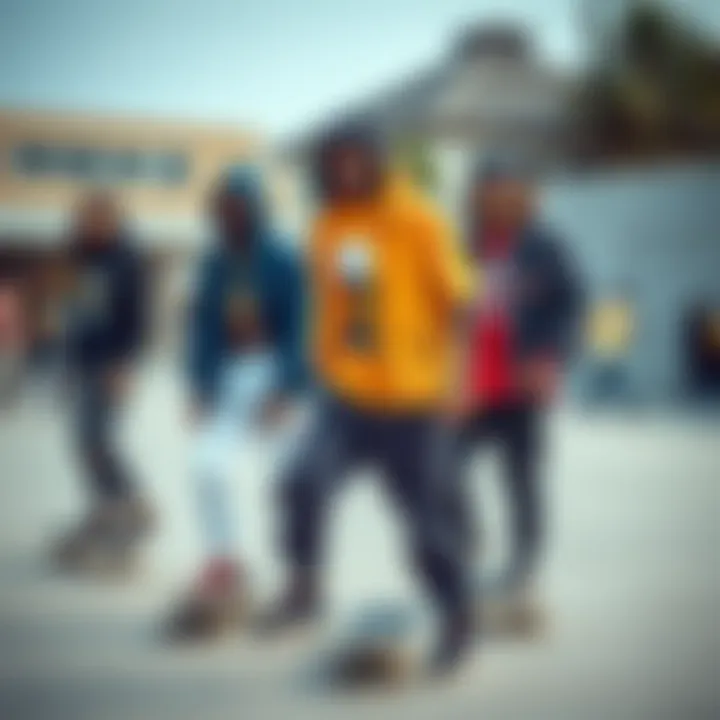
The Impact of Sustainable Practices
The adoption of sustainable practices in skateboarding clothing escalates beyond just a trend; it's a transformative shift in how the industry operates. Brands engaging in sustainability often embody enhanced transparency, giving consumers insight into their production methods, sourcing, and labor conditions. This transparency builds trust and fosters a community-centric approach that resonates with skateboarders.
Factor in the social impact, and you'll see that supporting sustainable brands often translates to supporting ethical manufacturing processes. Workers are treated fairly, and many brands invest in their communities, thereby uplifting the fabric of society involved in skate culture.
Moreover, adopting such practices can inspire future designers and brands to think critically about their contribution to the environment. The shift from fast fashion to slow, thoughtful fashion isn’t just beneficial; it’s essential for the sustainability of the skateboarding community and the planet.
Brand Collaborations and Their Impact
The skateboarding apparel landscape has been increasingly shaped by collaborations between brands and various influential figures. These partnerships often yield unique products that elevate the brand's visibility and resonate with consumers on a deeper level. The importance of brand collaborations cannot be overstated; they forge new pathways for creativity, drive sales, and connect with diverse audiences within the skateboarding community.
Celebrity Collaborations
Celebrity partnerships have become a cornerstone for many skate brands seeking to refresh their image while tapping into a broader audience. A notable example is the collaboration between Lil Wayne and Diamond Supply Co. This pairing not only brought hip-hop culture into the skate scene, but also introduced innovative designs that appealed to both communities. Such collaborations can create a buzz around the brand, seamlessly blending streetwear and high-end fashion, thus attracting a wider demographic.
Moreover, when skateboarding icons like Tony Hawk lend their names to specific products, it boosts authenticity. This connection encourages dedicated skateboarders to invest in merchandise that carries the weight of their idols’ endorsements.
Limited-Edition Releases
Limited-edition releases often stir excitement, creating a frenzy for skateboarders and collectors alike. Brands like Supreme have mastered the art of scarcity, where limited runs of certain skate gear lead to a rapid sell-through and increased desirability. Often, these releases come bundled with some element of surprise—whether it’s a unique design or an unexpected collaboration with a different industry, the limited nature elevates the perception of value.
"Scarcity drives demand. When skateboarders feel they must act fast to grab an exclusive item, it sparks excitement and a sense of belonging to a culture that thrives on uniqueness."
These offerings require careful consideration; brands must strike a balance between exclusivity and accessibility. If done correctly, limited-edition gear not only enhances brand reputation but also fosters loyalty among consumers who feel like they are part of an exclusive community.
In summary, collaborations—be they with celebrities or limited-edition drops—are pivotal in defining the current landscape of skateboarding clothing brands. They instigate excitement, enhance visibility, and create a bridging point between various cultural influences, essential for engaging the skateboarding community while pushing the envelope of what skate fashion can achieve.
Regional Variations in Skatewear
The landscape of skatewear is as diverse as the skateboarders who don it. Understanding the regional variations in skatewear is crucial not only for brands but for the skaters themselves. Fashion in skateboarding often reflects local culture, lifestyle, and even climate, influencing styles and preferences that emerge in different geographic areas. Recognizing these differences allows brands to cater to specific communities effectively. Moreover, it helps skateboarders express their identity through fashion while resonating with their local scene.
North American Trends
In North America, skateboarding’s roots run deep, with a history that often intertwines with punk and hip-hop cultures. Here, the fashion is heavily influenced by a mix of these musical styles, resulting in a gritty, urban aesthetic. The typical skatewear is often characterized by oversized tees, rugged denim, and hoodies emblazoned with logos or unique graphics. Notable brands like Vans and Thrasher have pioneered this look, promoting casual yet functional attire designed for both performance and style on the board.
The focus on comfort is paramount, as skaters prioritize gear that withstands the rigors of tricks and falls. Layering is common due to fluctuations in weather across regions, making items like flannel shirts and beanies popular choices among skaters, particularly in northern states where temperatures can dip significantly. As skate culture continues to evolve, we also see an integration of higher-end streetwear aesthetics, pushing boundaries with collaborations that mix high fashion and skate influences.
European Styles
European style, on the other hand, brings a unique flair to skatewear that often differentiates itself from its North American counterparts. The focus here often shifts towards a more tailored and minimalist approach. Brands such as Palace Skateboards and Stüssy emphasize clean lines and subtle branding, reflecting a chic, urban sophistication.
Moreover, European skaters are known to incorporate a variety of elements from the local fashion scene, including blends of vintage and contemporary styles. In cities like London and Paris, you’ll find skateboarders mixing classic pieces with innovative designs, showcasing sneakers that might even draw from the runway.
"Skateboarding in Europe isn't merely about tricks; it's a canvas for personal expression, a blend of style and culture."
Despite the changes, durability remains key. European brands focus on using high-quality materials that not only look good but hold up during intense use. There’s a growing trend toward sustainability, with many brands opting for environmentally friendly practices including the use of recycled materials.
Asian Influences
Asian influences in skatewear vary quite a bit, with regions like Japan leading the charge in unique, fashion-forward designs. Japanese skate culture often embraces street art and elaborate graphics, creating a vibrant visual language that stands out globally. Brands like Kiks TYO showcase bold patterns and bright colors, reflecting the dynamic nature of street life in cities like Tokyo.
Meanwhile, in Southeast Asia, affordability is a primary concern. Local skate brands strive to find the balance between quality and cost, often producing practical attire that’s accessible to younger skateboarders. This pragmatic approach helps foster a growing community of skaters who desire style but are also mindful of their budget.
Fashion shows in these regions often incorporate skate styles, creating a cross-pollination of ideas that influences local trends. Local celebrities and influencers also play a significant role in how styles develop, as they bring attention to various skate brands. Online outlets and social media platforms showcase these influences, making it easier for global trends to seep into Asian skate culture while still staying true to local roots.
The Role of Social Media in Brand Visibility
In the digital age, social media serves as a powerful catalyst for brand visibility, particularly in niche markets like skateboarding apparel. For many brands in this industry, platforms such as Instagram, TikTok, and Facebook are not just supplemental advertising tools; they have become the backbone of their marketing strategies. Why is this so important? First, social media breaks down geographical barriers, allowing brands to connect with a global audience. It's easier than ever for a small company based in southern California to reach customers all the way in Australia or Europe. This extended reach could change the fortune of a budding business overnight.
Another significant element is the fast-paced nature of social media. Trends can flare up and fade quickly, making it essential for brands to stay ahead of the curve. Brands that can quickly adapt their message or products in response to viral trends often see a substantial increase in engagement and, ultimately, sales. An effective strategy in this arena often requires a deep understanding of the target market—not just who they are, but how they think, act, and what they want from their skatewear.
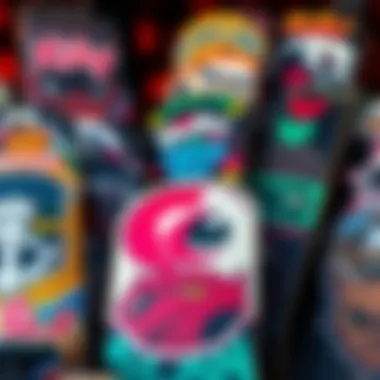
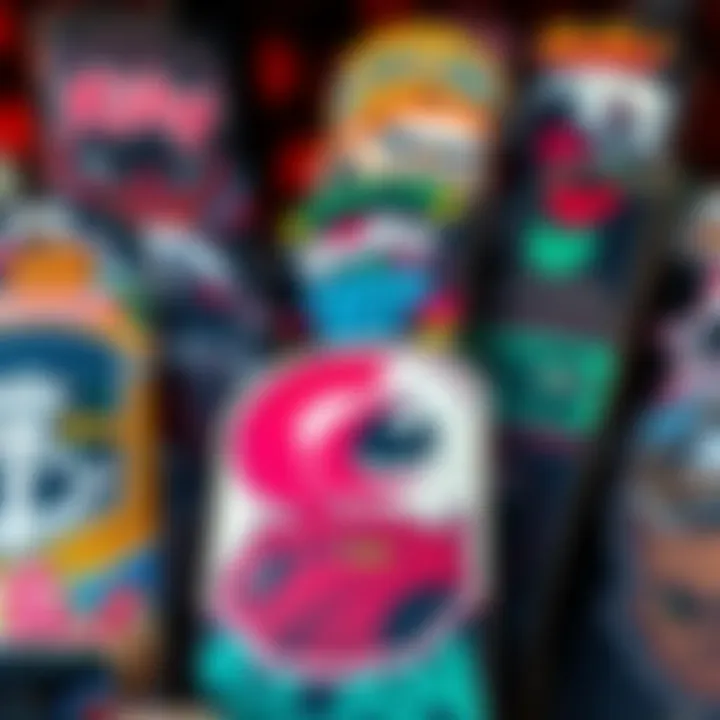
Influencer Marketing
Influencer marketing has become a household term, particularly in skateboarding communities. A skateboarder with a few thousand followers may attract a special kind of attention that larger celebrities simply can't. This micro-influencer effect can yield a level of authenticity and relatability that major endorsements might miss. Skate culture thrives on genuine connections, and when a respected skater showcases their favorite brand, it resonates deeply with their audience.
- Trust Factor: Followers are more likely to purchase from brands promoted by someone they know and trust.
- Niche Targeting: Influencers often have well-defined audiences that align closely with specific brands.
Brands like Baker Skateboards or Thrasher have tapped into this trend effectively, working with local influencers who genuinely embody the spirit of skate culture. Collaborations might include limited edition apparel lines or even co-hosted events, creating content that drives conversation and engagement back to the brand.
User-Generated Content
User-generated content (UGC) serves as an honest representation of a brand's impact on its community. This kind of content might include videos of skate sessions featuring brand apparel, photos shared by customers showcasing their favorite pieces, or even stories that talk about personal experiences with the brand. This affects brand visibility in a couple of crucial ways.
- Authenticity: UGC is viewed as more trustworthy by peers compared to polished brand advertisements.
- Community Building: By encouraging fans to share their experiences, brands foster a sense of belonging that can significantly strengthen customer loyalty.
Brands such as Element Skateboards actively promote UGC through their social channels, creating campaigns that spotlight customer involvement. This not only gives them a wealth of content to share but allows skateboarders to feel like they are a part of something bigger.
"The connection between brands and communities in skating runs deeper than just selling clothes; it’s about fostering a cultural identity."
In summary, social media is more than just a marketing tool in the skateboarding apparel landscape. It’s a way for brands to connect, adapt, and thrive in an ever-changing environment.
Understanding Skateboarder Preferences
When discussing skateboarding clothing, it's vital to recognize how skateboarders themselves shape and influence their attire. Understanding skateboarder preferences goes beyond mere aesthetics; it's about recognizing their choices based on performance, comfort, and personal expression.
Selecting Gear for Performance
Skateboarders are often looking for gear that doesn't just look good but also performs well. Selecting the right clothing can greatly impact their skating abilities. A pair of pants may appear stylish, but if they restrict movement, a skater will quickly find them lacking.
Some of the must-consider elements include:
- Material: Breathability is key. Fabrics such as cotton blends or moisture-wicking materials are preferred since they provide ventilation.
- Fit: Loose-fitting clothing offers more freedom during tricks, whereas a snug fit can hinder mobility.
- Durability: Skateboarding can be tough on clothes. Reinforced seams, durable fabrics, and even specialized stitching are essential for keeping gear intact under pressure.
The preferences vary geographically too. In North America, streetwear styles dominate; in contrast, European skate culture may favor more tailored cuts. Skaters often choose equipment that resonates with their local environment, which highlights how their preferences align with their cultural context.
Personal Style vs. Practicality
Another layer to these preferences is the tug-of-war between personal style and practicality. For many skateboarders, the look is just as important as the function. They seek the sweet spot where style does not compromise the utility of the gear.
Consider the following points on this topic:
- Self-Expression: Skateboarding is an individualistic sport. Many skateboarders want to showcase their identity through unique clothing styles. This could be oversized tees, bold graphics, or vintage finds that set them apart from the crowd.
- What Works: While skaters might adore the latest trends on social media, they must also factor in the practicality of the gear they choose. A skater's personal style carries more weight if it can withstand the rigors of skating—chasing the latest fad without considering functionality could lead to disappointment.
- Community Feedback: The skate community often plays a role in shaping personal preferences. Recommendations from fellow skaters can lead to a broader acceptance of specific styles or brands, illustrating how the social environment intersects with individual choices.
In sum, understanding skateboarder preferences serves as a foundation for appreciating the fashion statements made in skate culture. Whether navigating the fine line between style and function or selecting performance-driven gear, skaters are always defining the narrative within their clothing choices.
"The right gear can elevate performance, but personal style fosters community and individuality. It's a balancing act that every skater navigates."
Links for further reading include Wikipedia Skateboarding and articles from Britannica.
Epilogue: The Future of Skateboarding Apparel
As we step into a realm where skateboarding continues to influence broader fashion trends, it becomes crucial to consider the evolving nature of skateboarding apparel. The intersection between culture and clothing reflects not just the artistry of skateboarders but also the adaptability of brands to meet their demands. Understanding this relationship sheds light on future possibilities, paving the way for innovative designs and sustainable practices.
Trends to Watch
- Sustainable Materials: An increasing number of brands are shifting toward eco-friendly materials. Skateboarders are becoming more environmentally aware, leading companies to invest in sustainable fabric options that reduce their carbon footprint. Biodegradable materials and recycled plastics are anticipated to gain traction.
- Technological Integration: The upcoming years may see more brands incorporating technology into their clothing. Think moisture-wicking fabrics, built-in UV protection, and even smart textiles that adapt to temperature changes. This would not only enhance performance but also offer skaters additional comfort.
- Customization: Personalization is on the rise. With the availability of digital printing technology, brands might offer more customizable options for skaters to express their unique identity. This could mean everything from choosing colors to adding personal artwork.
- Gender-Neutral Designs: More brands recognize the need for inclusivity in design. We are likely to see a surge in gender-neutral skate apparel, allowing every skateboarder, regardless of gender, to find gear that suits their personal style.
- Collaboration with Local Artists: As skateboarding culture thrives in local communities, collaborations with local artists and designers could become more prevalent. This could bring about original, culturally relevant pieces that resonate more deeply with skaters.
"Skate fashion isn’t just about clothing; it’s a language of self-expression that evolves with its native culture. "
The Continuing Evolution of Skate Culture
Skateboarding culture has gone through various phases, from its rebellious roots in the 1970s to its mainstream acceptance today. Yet, through all these changes, the essence of skate culture remains grounded in creativity and authenticity.
- Diverse Influences: As more skaters come from varied backgrounds, the cultural influences in skate fashion continue to diversify. This results in a blend of styles that reflects global trends, making skateboarding apparel not only about functionality but also about storytelling.
- Enhanced Community Engagement: The future seems bright for community-driven initiatives that unite skaters. From local skate parks to global skateboarding events, these communal aspects will drive demand for apparel that celebrates local culture while remaining comfortable for the sport.
- Digital Presence: The digital landscape is resourceful for skate culture. Emerging platforms allow skaters to share their style, tricks, and stories, influencing both established and new brands. As these narratives grow, there may be a surge in shop-to-skate features that enhance the connection between skateboarders and the brands they wear.
- Fashion Week Presence: Skateboarding's fusion with high fashion is not a passing phase. It’s expected that more brands will debut their collections at major fashion shows, further elevating skate culture as a legitimate segment of global fashion.
- Resilience amid Challenges: The industry has faced setbacks, but the love for skating has not wavered. The adaptive spirit of skateboarders will continue to inspire brands to innovate and create apparel that withstands not only the wear and tear of the sport but also the ever-changing economic landscape.
In retrospect, the future of skateboarding apparel is a dynamic mix of creativity, culture, and conscious design. The skateboard community’s preferences will undoubtedly shape the marketplace, ensuring that the brands not only adapt but thrive in this vibrant culture.



